A major digital shift has occurred in India's restaurant business. A trendy and practical website is now an absolute must for eateries in India.
In India's restaurant business, there is a clear split between organized and unorganized sectors of food businesses. With a focus on a simplified supply chain and strict quality control, the organized section showcases a well-developed and ordered framework. From 2023 to 2026, the organized food service industry anticipates to expand at a CAGR of 15%, outpacing the unorganized sector.
However, majority of food businesses operate in the unorganized sector, which includes places like roadside eateries, dhabas and food stalls.
The projected growth rate for India's food services sector is Rs 9 trillion by 2030. Everyone who owns a restaurant, organized or unorganized, needs a strong website for marketing and other reasons.
A well-designed restaurant website features online bookings, directions, and a menu. For a restaurant to build a successful online presence, its website should entice visitors with its appetizing meals, guided easily through the site, and provided with clear information about the online ordering system.
If you've never built a website for your restaurant before, this article will work as a full-fledged tutorial.
Importance of a restaurant website
In today's digital world, having a website is essential for any restaurant business. A website acts as a central hub for your online presence, providing potential customers with key information about your restaurant. It serves as a platform for showcasing your menu, location, contact information, and special promotions.
Moreover, a website enhances your restaurant's credibility and professionalism, making it easier for customers to find and choose your restaurant.
1. Building a brand and online presence
Any company serious about succeeding in today's digital market must have a website. Your website allows you to build your brand by showcasing your restaurant's unique style, ambiance, and culinary offerings. Customers may read your restaurant menu, see photos of your dishes, and make a reservation all from the comfort of their own homes with a restaurant website.
2. Increased visibility
A website increases your restaurant's visibility in search engines, making it easier for potential customers to find you. It is also a simple and effective medium for advertising. You may feature your most popular meals, provide testimonials from satisfied customers, and publicize upcoming events and sales. Your website can also provide convenient information, where ustomers can easily access your menu items, operating hours, and location details online.
3. Ability to accept online reservations
Businesses fail and miss out on opportunities when they depend just on walk-in reservations. In today's fast-paced eating scene, people appreciate the ease of booking a table through the website. Providing a simple table reservation process via your website is the best approach to attracting both new and repeat customers.
4. Increase customer engagement and attract more diners
One of the best ways to increase potential customers' awareness of your restaurant business is to launch a customized website. A lot of people these days use search engines and social media links to find restaurants and place food orders.
The website provides a platform for engaging with customers through online reservations, newsletters, and feedback forms.
Search engine optimization (SEO) raises your restaurant's visibility in organic search results, which in turn increases the likelihood that prospective customers will come across your website. Both your brand's exposure and your chances of gaining new customers are greatly enhanced by this restaurant marketing technique.
5. Maximize your online orders
The meal delivery market is expected to reach its peak in 2028, with 2.5 billion users. If a restaurant owner has a website, customers can place orders easily without having to call the restaurant directly.
In order to make things even more convenient for your consumers, you must also accept payments online.
Types of restaurants in India
1. Traditional restaurant
Traditional restaurants give an immersive eating experience, allowing guests to thoroughly immerse themselves in their meals in an atmosphere. Nowadays, it's rare for a traditional restaurant to not have a website.
Building a website simply means standing out online and showcasing your one-of-a-kind eating experience.

2. Cafes
Cafes are welcoming spaces for people to meet and chat. Modern cafés spare no effort to ensure that you have a pleasant experience. These charming cafes get a much-needed boost by creating a restaurant website.
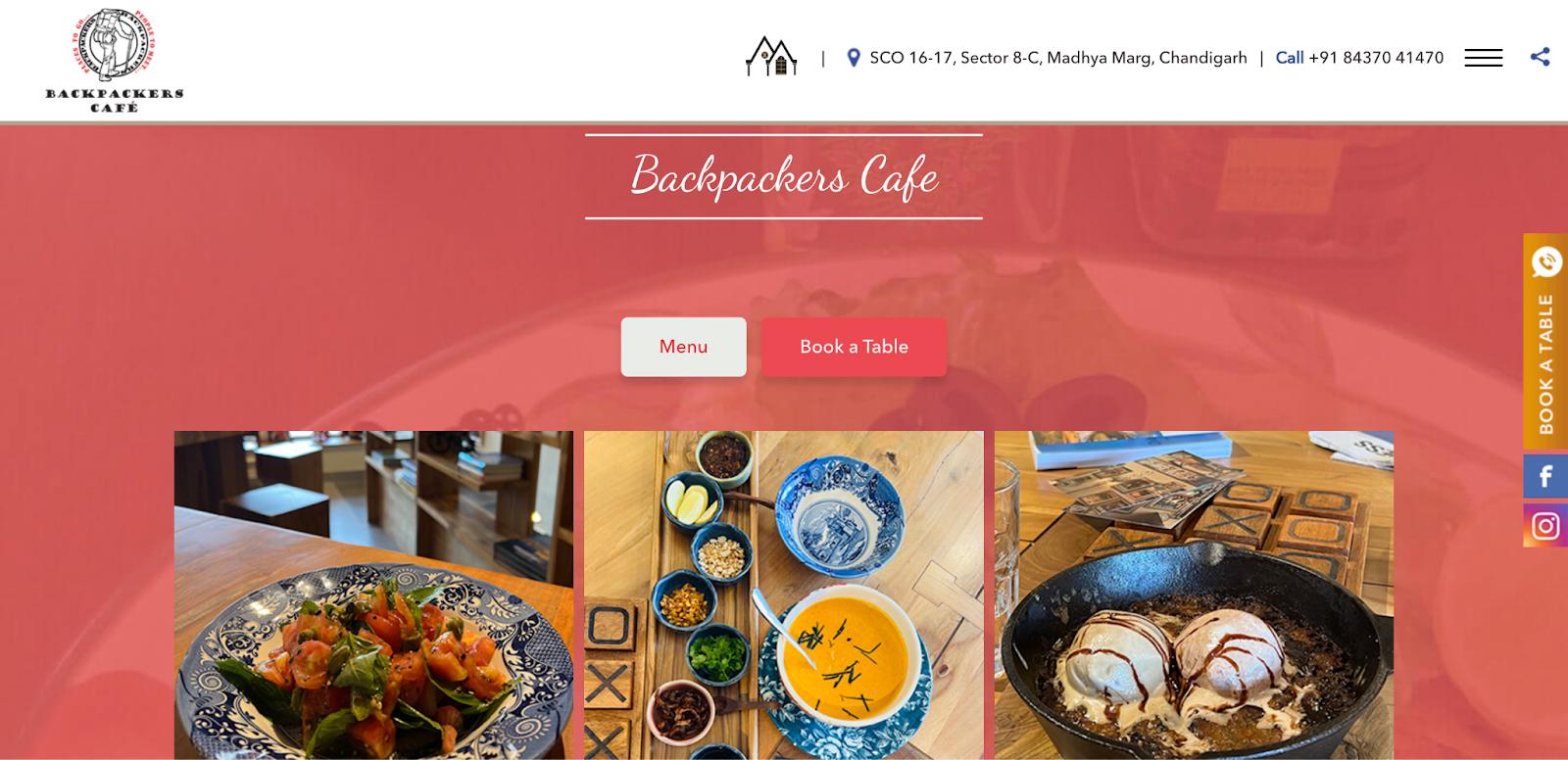
3. Food stalls
The soul of India is its street food. Street vendors and food stall owners have a dedicated following, and some of them even have their own websites to attract customers from all over the world. One famous example is the 'Vada Pav Girl', who took to the internet by storm after selling Mumbai-style Vada Pav in a small stall in Delhi.
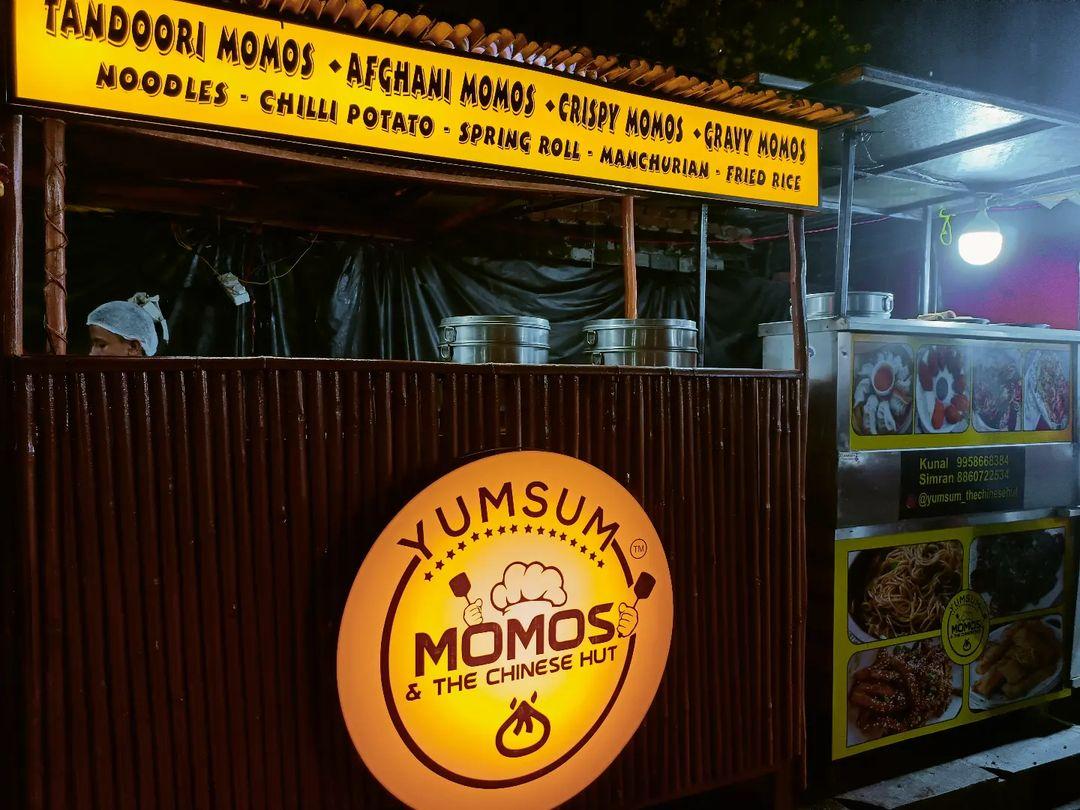
4. Food trucks
Despite being a Western fad, the food truck culture is quickly taking over urban India. Owners of food trucks in India are coming up with all sorts of creative ways to get people to order and eat. One strategy should be to create a website that shows up in Google searches.
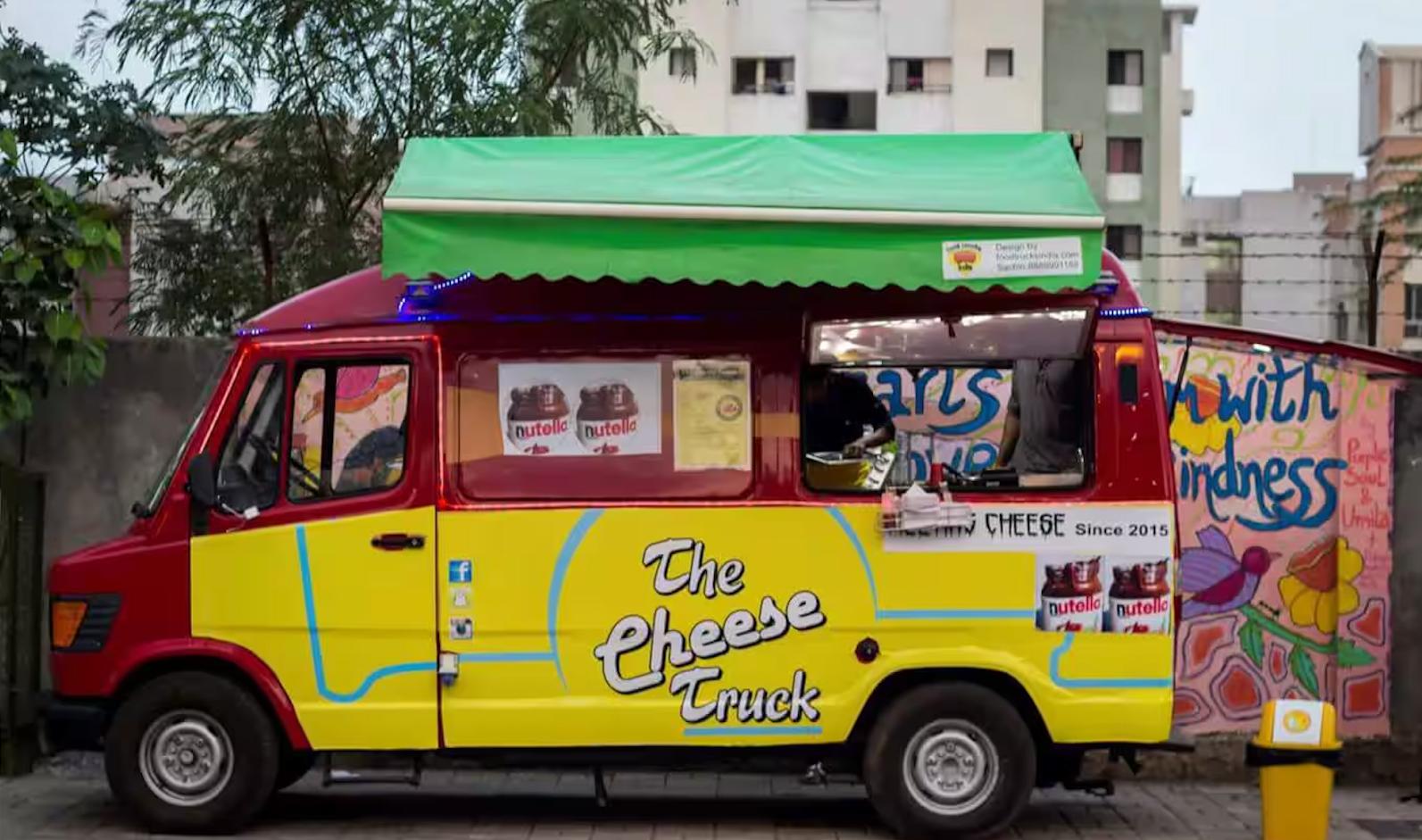
Step-by-step guide to building a restaurant website
A restaurant website is a great first step in taking your physical restaurant online. While it's now simpler than ever to build a restaurant website, there are still some important things to ensure. Here are the given steps to follow:
Step 1: Pick a domain for your restaurant
It is critical to choose the correct domain name. To make your website stand out, adopt a top-level domain (TLD) linked to food, such as .restaurant, .cafe, or .food.
Names that are simple to spell and say are more likely to stick in the minds of your potential customers. Make sure the domain you want is accessible and not too similar to other famous restaurants.
Related: What is a domain name?
Step 2: Select a web hosting plan
The web hosting industry is vast, so it's important to choose a provider with a solid reputation for site dependability as well as a range of plans to suit your specific requirements. You can select a web hosting plan that offers these at a reasonable price.
Restaurant owners can maintain a credible online presence without going into debt by following these steps to choose an affordable web hosting service:
- Shortlist a few web hosting service providers.
- Think about storage, bandwidth, security, user experience and support while comparing options.
- Look at ratings and reviews.
- Pay for the selected plan and set up your account.
- Install a content management system (CMS) or a website builder on your site.
Important considerations for selecting a reliable web hosting provider
Your website's performance and general functionality may be greatly affected by a number of important criteria when choosing a web host. Before all else, consider these three crucial aspects:
Uptime
What exactly is uptime? How often your website is available to users is called its uptime.
If your site goes down, you lose prospective customers and traffic. So, having a high uptime is very important. Having an uptime that is very near to 100% is ideal. Because even a single hour of downtime may have a major effect on your business.
Websites built with GoDaddy run the fastest on desktops, scoring 92.06%. For optimal performance, go with such a powerful web host for your freelance platform.
Loading speed
Users get frustrated and are more likely to leave a website if it takes too long to load. Moreover, page load speed is now one of Google's ranking factors.
Search engines and users alike will appreciate faster page loads, so look for a web host that can achieve this goal.
Customer service
When dealing with technological difficulties or requesting help, having a dependable customer care staff can be very crucial.
Always choose a web hosting plan that provides a variety of ways to get in touch with them, such as call, chat, email, and ticketing systems. What matters most, however, is how quickly they respond and how knowledgeable their support staff is. In order to fix any issues with a website, having trustworthy customer service is crucial.
The point is that you can't ignore website performance issues. If you’re a beginner who is just starting out in the restaurant industry, you can't afford to turn down any prospective customer.
Step 3: Choose the right platform to build your website
A number of options exist for you to choose from when you plan to build a restaurant website. Restaurant website builders that cater to restaurants are the ones that provide responsive design.
One of the best restaurant website builders, like GoDaddy Web Builder is well-liked due to their intuitive interfaces and wide variety of configurable layouts.
Those unfamiliar with web design will find it an approachable alternative due to the abundance of pre-made templates and features that do not need an understanding of code.
Related: How much does it cost to build a website in India?
Step 4: Define your website’s purpose
Showcase your restaurant's specialities on your website. Think about who you're serving, what they like, and the atmosphere. The look and feel of your restaurant website should permeate all aspects of your service.
60.9% of experts anticipate an increase in the popularity of cuisine-agnostic, chef-owned/led delivery restaurants. Therefore, if you are associated with top-tier chefs and a variety of cuisines, be sure to highlight this on your website.
Step 5: Choose a template
After you've established the purpose, choose a template that fits well with your restaurant business. Think of a template as a blueprint for your restaurant’s style and structure.
Draw people’s attention by showcasing your restaurant's cuisine and adding a distinctive layout as they navigate your website. The template should complement the vibe of your own restaurant.
You should choose a mobile-friendly theme as many of your guests will be using their smartphones to visit your site. Users' screen sizes should be considered while designing the template. Make sure your restaurant site displays properly on every device.
You can choose from various templates on GoDaddy's professionally designed website templates. Pick one that is both aesthetically pleasing and useful for your website.
Here is the initial setup process:
- Decide The Right Template
Firstly, go to the "Pick a Template" area on the GoDaddy Studio site. Several social media and logo alternatives are available under the template section. Another option is to use the search field to locate a certain term, such as "food" or "professional."
- Make Your Own Template
Click on the templates you like most to access them in the design editor. Now personalize it to your liking. You can add images, visual elements, icons, typography videos, and text.
The intuitive features in GoDaddy Studio make it easy for beginners to customize restaurant website templates as per their exact specifications.
Step 6: Customize Your Website
To begin, upload your logo and choose a color palette that reflects your brand's identity. A logo is like a small visual anchor; it helps people remember your restaurant name whenever they see it. The next step is to add pages to your template so that it fulfills your purpose.
Essential pages for a restaurant website
1. Home Page
Your homepage is the first thing visitors see. A home page does double duty as an attention grabber and a description of your restaurant's unique offerings and specialization.
Craft an enthralling gourmet adventure with thoughtful website design. A mesmerizing background video showing chefs plating famous dishes might entice diners and give them a sneak peek inside the restaurant.
2. Menu page
Your online menu is one of the most important aspects of your website. Make sure it is easy to read and includes enticing descriptions of your dishes.
A lot of web designers are coming up with creative and eye-catching ways to write down menu items. Give each dish a thorough description, and show its price. Try to also attach high-resolution images along with the dishes.
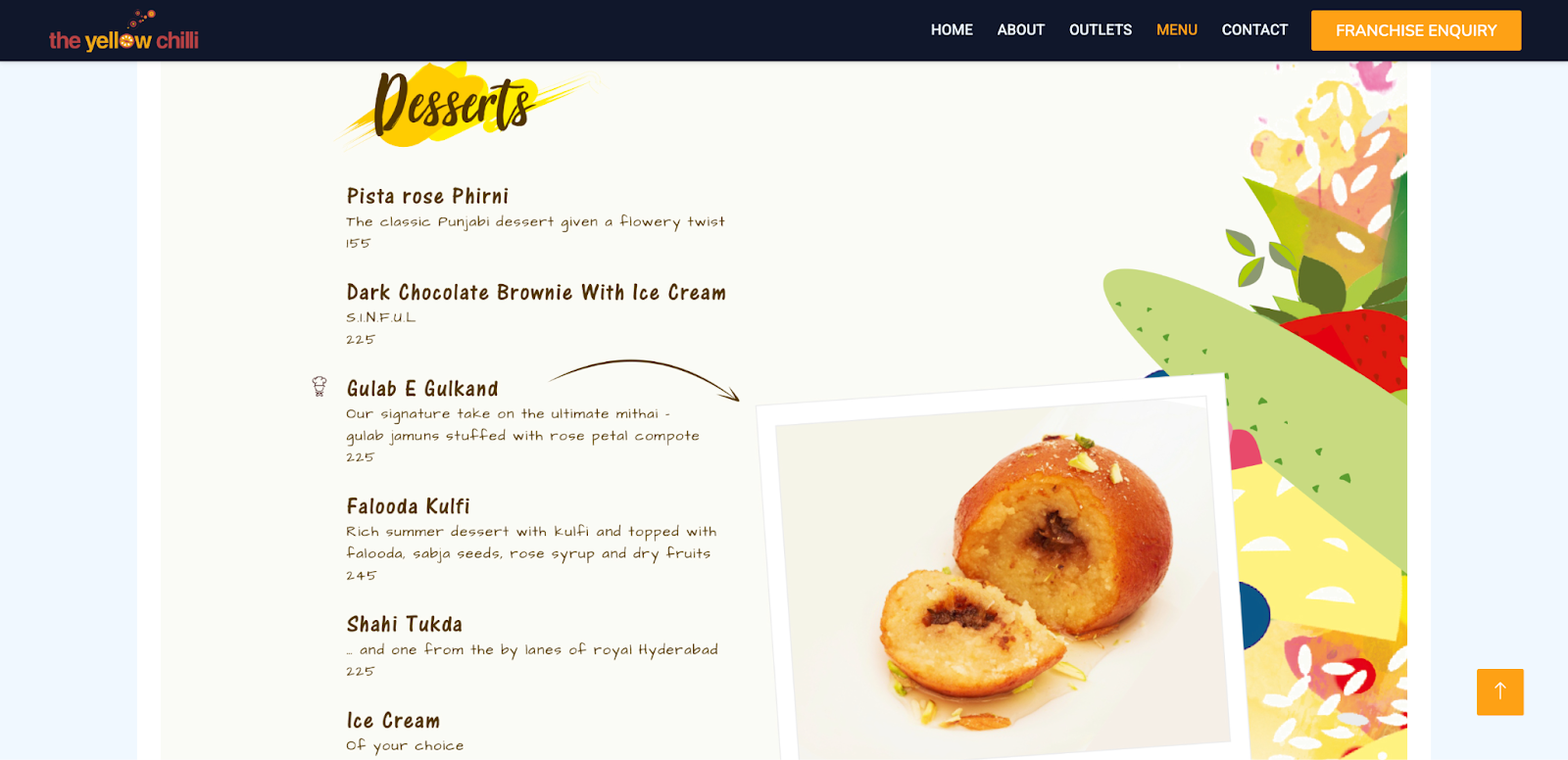
Source: theyellowchilli.com
3. Contact Us page
This page should include your contact information such as address, phone number, and email. Including a map can also be helpful for customers trying to find your location.
If you already have a newsletter, you may include a subscription or contact form to invite people to become exclusive members of your restaurant.
4. Reservation page
For restaurant owners, menus are more than just a list of food items; they are an integral part of their website. If a restaurant wants to attract the ideal consumers, it needs a well-designed menu that showcases its offerings. For this reason, its layout must be meticulously planned.
In order to stay competitive, restaurants need to provide menu items that can be ordered online quickly and then picked up and delivered to customers' homes. This process might be made easier with user-friendly web plugins.
5. Gallery
Make sure to add a gallery page that embodies your restaurant's breathtaking food and ambiance. Customers will be more likely to visit your business after seeing high-quality images. Make your photographs speak for themselves.
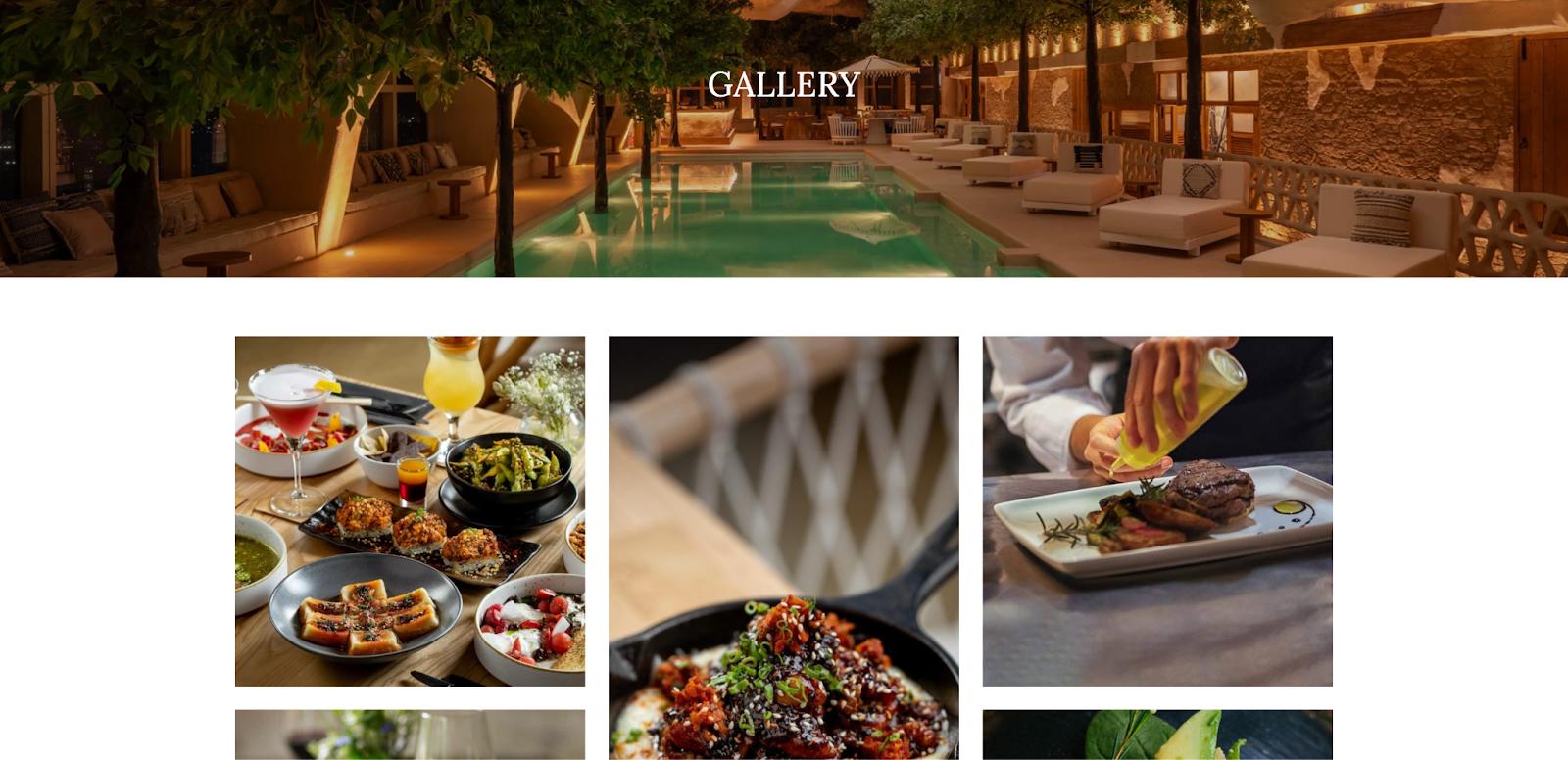
6. Blog Page
Posting updates on special events, new menu items, or seasonal promos on a blog is a great way to keep customers involved.
Make sure to talk about your restaurant's specialty whether it's a different form of Indian cuisine or a specialized kind of food item; this will attract readers and serve as an advertisement for your website.
Related: How to create a beautiful one-page website?
Step 7: Optimize your website for SEO
Search engine optimization (SEO) is an ongoing process. Using powerful SEO tactics can elevate your website to new heights.
First things first: make sure your restaurant website is built, optimized, and functioning effectively. This will set you up for a successful website in the long term. A well-rounded SEO strategy also takes into account off-site advertising, link development, and social media marketing.
Here are the two most common SEO practices:
- On-page SEO: On-page SEO is the method you may use on your website itself (front end) to improve search engine optimization and make your page more comprehensible to website crawlers.
- Off-page SEO: Off-page SEO is about the things you can do outside of your site to improve your SEO, such as getting more high-quality backlinks.
It is important to ensure that the restaurant is likewise listed on Google My Business in order for them to get Google Reviews. Having high ratings shown on search engine results pages (SERPs) helps clients discover your restaurant, as 73% of all online reviews are hosted by Google.
Another essential tool for connecting with prospective consumers is your Yelp profile. You may make it easier for consumers to discover and support your restaurant online by maintaining an up-to-date Yelp page.
You can also use SEO tools in the GoDaddy Digital Marketing suite to improve your site's visibility in search engines and attract more customers before you release your website to the public.
Step 8: Launch your website
The last step is to launch your restaurant website. Once your basic web pages are created and you're satisfied with how everything appears, click the publish button. Upload your initial material and make adjustments and updates as you go.
Promoting your website is essential if you want to attract first-time visitors. This can be done in a variety of ways, including linking it from your social media profiles, creating targeted ads, and more. Also, put your website's URL on all of your restaurant's physical products, such as menus and takeout bags.
Start building your restaurant website today!
Building a restaurant website doesn't have to be complicated. A website builder like GoDaddy and its pre-designed templates can simplify the process, allowing you to create a professional, SEO-optimized website for your freelance business. A website is not just a digital presence; it's a powerful marketing tool that can help you attract clients, showcase your work, and establish your brand in the freelance market.
Frequently Asked Questions (FAQs) about building a restaurant website in India
1. What are the most important features to include on a restaurant website?
To ensure your restaurant website is effective, include the following:
- SEO Optimization: Optimize your website for search engines to improve visibility and attract more visitors.
- Responsive Design: Ensure your website looks great on all devices, including smartphones and tablets.
- Clear Call-to-Action: Encourage visitors to take specific actions, such as making a reservation or signing up for a newsletter.
- Social Media Integration: Link to your social media accounts to encourage further engagement with your brand.
2. How can I optimize my restaurant website for SEO/search engines?
To optimize your restaurant website for search engines, consider the following strategies:
- Keyword Research: Identify relevant keywords that potential customers might use to find your restaurant online.
- On-Page SEO: Use keywords strategically in your website's titles, headings, and content.
- Local SEO: Optimize your website for local search by including your location in your keywords and setting up a Google My Business profile.
- Quality Content: Publish high-quality, engaging content that provides value to your visitors.
3. What features should a good restaurant website include?
A good restaurant website should be visually appealing, easy to navigate, and provide all the information customers need to make a dining decision. Essential features include:
- High-Quality Photos: Use professional images to showcase your dishes and ambiance.
- Clear Information: Provide all necessary details such as hours of operation, address, and menu.
- Online Ordering System: Offer online ordering for takeout or delivery if applicable.
4. How to optimize a restaurant website for online reservations?
To optimize your restaurant website for online reservations, consider these tips:
- Reservation System: Integrate a reliable reservation system that allows customers to book tables easily.
- Call-to-Action: Use clear and compelling calls-to-action to guide visitors towards making a reservation.
- Mobile-Friendly: Ensure the reservation system is mobile-friendly to accommodate users on smartphones.
- Confirmation and Reminders: Send confirmation emails and reminders to reduce no-shows.
5. Other additional considerations for building a restaurant website?
Local cultural preferences
When designing a restaurant website in India, consider local cultural preferences and dietary habits. Highlight any regional specialties and ensure that menu items cater to local tastes.
Web hosting and domain name
Choose a reliable web hosting provider to ensure your website runs smoothly. Select a domain name that reflects your restaurant's name and is easy for customers to remember.
Marketing strategy
Implement a comprehensive marketing strategy to promote your restaurant website. Use SEO tools, email marketing, and social media links to reach a wider audience and attract new customers.










